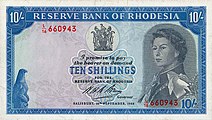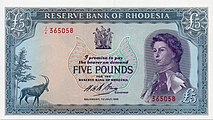Queen of Rhodesia
| Queen of Rhodesia | |
|---|---|
Coat of arms of Rhodesia | |
 Stamp issued 1966 | |
| Details | |
| Style | Her Majesty |
| Formation | 11 November 1965 |
| Abolition | 2 March 1970 |
Queen of Rhodesia was the title asserted for Elizabeth II as Rhodesia's constitutional head of state following the country's Unilateral Declaration of Independence from the United Kingdom. However, the position only existed under the Rhodesian constitution of 1965 and remained unrecognised elsewhere in the world. The British government, along with the United Nations and almost all governments, regarded the declaration of independence as an illegal act and nowhere else was the existence of the British monarch having separate status in Rhodesia accepted. With Rhodesia becoming a republic in 1970, the status or existence of the office ceased to be contestable.
History

Southern Rhodesia had been a crown colony with responsible government since 1923 and the transfer from rule under the British South Africa Company. The monarch of the United Kingdom was automatically recognised as monarch in the colonies. Following the UK refusing to grant Southern Rhodesia independence under minority rule, on 11 November 1965, they unilaterally declared independence and declared Elizabeth II as the queen of Rhodesia.[1] The independence declaration clarified that they were only breaking from the British government and affirmed loyalty to Elizabeth, viewing her as the separate Rhodesian monarch as part of a "loyal rebellion".[2] All Rhodesian oaths continued to be taken to her and the declaration of independence ended with "God Save The Queen".[3]
In response, the
Accordingly Smith appointed
Power
The monarch's powers were the same as prior to the
Be it enacted by His Excellency the Officer Administering the Government as representative of the Queen's Most Excellent Majesty, by and with the advice and consent of the Parliament of Rhodesia
In 1968, she commuted the sentence of three African men sentenced to death.[9] Her pardon was ignored as the High Court of Rhodesia ruled that, as Rhodesian officials had not been consulted, the pardon came from the orders of the British government rather than from the Queen of Rhodesia, and the men were executed.[10][11][12]
Symbols
The Queen's portrait featured on Rhodesian banknotes and coins, as well as on postage stamps.[13]
- Queen Elizabeth II on Rhodesian banknotes
-
Ten shillings
-
One pound
-
Five pounds
Abolition
There had been calls for Rhodesia to become a republic as early as 1966.[14] The Whaley Commission had been set up by the Rhodesian government in 1967 to review the constitution and recommendations for alterations.[15] After Queen Elizabeth II's pardon was ignored, the Rhodesian government announced that the Queen's Official Birthday would no longer be a public holiday and they would only fire a 21-gun salute on her actual birthday.[16]
The Rhodesian Front published the Whaley Report's proposals for a referendum to abolish the monarchy and establish a republic with a new constitution a month after the executions.
Contrary to Smith's hope that such a move would bring international legitimacy, it had the opposite effect. All countries that had relations with Rhodesia, except Portugal and South Africa, withdrew their diplomatic missions from the country. This was because originally they maintained relations because of the pre-existing royal accreditation but because a republic had been declared, that rationale was no longer valid.[24]
Rhodesia remained an unrecognised republic until Zimbabwe Rhodesia agreed to return to colonial status in 1979. Queen Elizabeth II resumed monarchical duties over the colony through her role as Queen of the United Kingdom and appointed Lord Soames as her representative as Governor of Southern Rhodesia until its independence as Zimbabwe on 18 April 1980.[25]
References
- ^ "As The Crown returns, watch out for these milestones". The Guardian. 18 August 2019. Retrieved 5 July 2021.
- S2CID 149475345.
- S2CID 226736902, retrieved 6 July 2021
- ^ ISBN 978-1107056787.
- ISBN 978-3030326982.
- ^ "Stuart Duke proposed as Regent of Rhodesia". The Guardian. 14 October 1965. Retrieved 5 July 2021 – via Newspapers.com.
- ^ a b "Lancaster House 1979: Part II, The Witnesses by FCDO Historians". Foreign and Commonwealth Office. 20 December 2019. p. 118. Retrieved 5 July 2021 – via Issuu.
- ^ Rhodesia, Southern (1966), Act to Ratify and Confirm the Constitution of Rhodesia, p. 22
- ^ "Rhodesia (Royal Prerogative of Mercy) (Hansard, 4 March 1968)". Hansard. 4 March 1968. Retrieved 5 July 2021.
- ^ "Retaliation threats made to Rhodesia". El Paso Times. 7 March 1968. Retrieved 5 July 2021 – via Newspapers.com.
- ^ ""In hanging the three Africans, the Smith regime has been true to its basic nature."" (PDF). American Committee on Africa. Retrieved 5 July 2021.
- ^ "Rhodesia Defies Queen's Reprieve; Hanging Ordered for Three Africans Long Doomed". The New York Times. 6 March 1968. Retrieved 5 July 2021.
- ISBN 9780230760943
- ^ "White Rhodesians salute Independence anniversary". Quebec Chronicle-Telegraph (Press release). 11 November 1966. Retrieved 5 July 2021 – via Google News.
- ^ JSTOR 2613004. Retrieved 11 August 2021.
- ^ "Queen". The Age. 20 April 1968. Retrieved 5 July 2021 – via Newspapers.com.
- ^ "Rhodesia proposes to become a republic". The Vancouver Sun. 17 July 1968. Retrieved 5 July 2021 – via Newspapers.com.
- ^ "Rhodesia ready to become a Republic". Red Deer Advocate. 18 July 1968. Retrieved 5 July 2021 – via Newspapers.com.
- ^ "Challenge By the Church in Rhodesia". The New York Times. 3 May 1970. Retrieved 5 July 2021.
- ^ Kandiah, Michael (2001). "Rhodesia UDI" (PDF). Institute of Contemporary British History. Retrieved 11 August 2021.
- ^ "That'll show them". Times Colonist. 16 March 1970. Retrieved 5 July 2021 – via Newspapers.com.
- ISBN 978-0199214235.
- ^ "Rhodesia becomes independent; seen as "just another dull occurrence"". Ames Daily Tribune. 2 March 1970. Retrieved 5 July 2021 – via Newspapers.com.
- ISBN 978-0-8156-2161-4.
- ^ "Rhodesia Restored To Colonial Status". The New York Times. 13 December 1979. Retrieved 5 July 2021.



